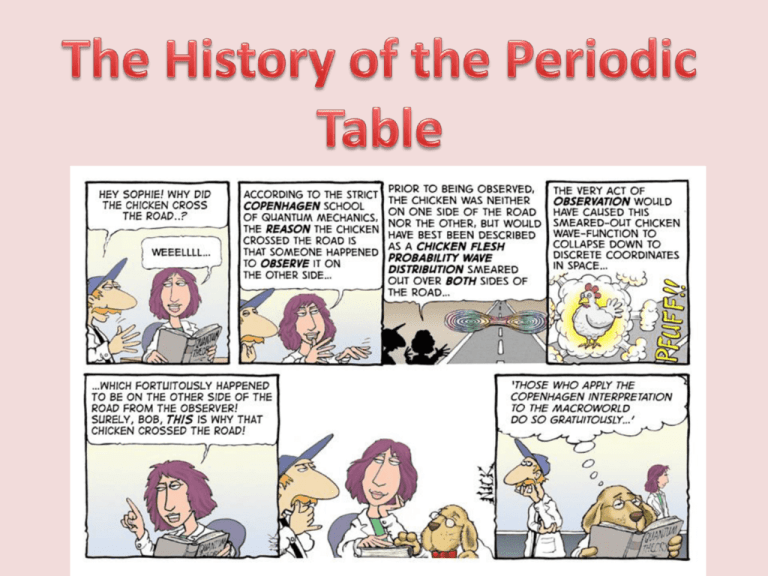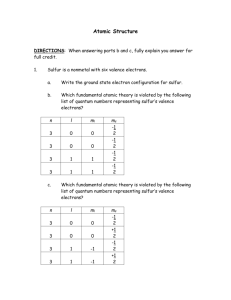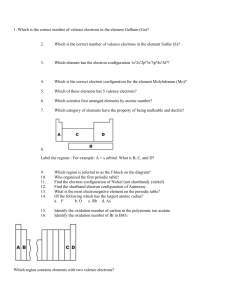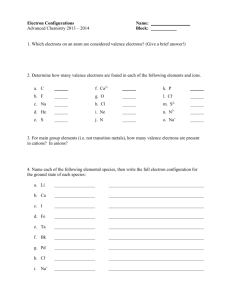Ch. 7 Sections 7.10 and 7.12 Powerpoint
advertisement

•Originally constructed to represent the patterns observed in the chemical properties of the elements. •First chemist to recognize patterns was Johann Dobereiner (1780-1849). •Noticed several groups of three elements had similar properties, for example, chlorine, bromine, and iodine. •Tried to expand his model of triads but it was severely limited. •Next notable attempt was made by John Newlands in 1864. •Suggested that elements should be arranged in octaves. •This was based on the idea that certain properties seemed to repeat for every eighth element. •Model did attempt to group based on properties but not generally successful. •Present form of periodic table conceived by Julius Lothar Meyer (1830-1985) and Dmitri Mendeleev (1834-1907). Meyer Mendeleev •Mendeleev is given most of the credit because he emphasized the table could be used to predict the existence and properties of unknown elements. •He published his table in 1872. •Mendeleev predicted the existence and properties of the elements gallium, scandium, and germanium from gaps in his periodic table. •Germanium was discovered in 1886 and his predicted values and those observed are in excellent agreement. •Mendeleev was also able to predict atomic masses of several elements, including indium, beryllium and uranium. •Mendeleev’s table was almost universally adopted and remains one of the most valuable of a chemist’s tools. •The fundamental difference between Mendeleev’s table and the modern periodic table is the modern table uses atomic number to order the elements rather than atomic mass. •Valence electrons are the electrons in the outermost principal quantum level (outermost energy level) of an atom. •Electron configuration for nitrogen: 1s22s22p3 •The valence electrons for nitrogen are the 2s and 2p electrons; therefore, nitrogen has five valence electrons. •Valence electrons are important because they are involved in bonding. •Core electrons are the inner electrons. •Elements with the same valence configuration show similar chemical behavior. •Groups 1, 2, 13-18 are often called the main-group or representative elements. •Every member of these groups has the same valence electron configuration. •Predicting the valence electron configurations of the transition metals, the lanthanides, and the actinides is somewhat more difficult because of the many exceptions. •There are observed trends in several important atomic properties: ionization energy, electron affinity, and atomic size. •The effective nuclear charge is the pull that an electron “feels” from the nucleus. •Effective Nuclear Charge (Zeff) = # protons - # core electrons •The closer an electron is to the nucleus, the more pull it feels. •As effective nuclear charge increases, the electron cloud is pulled in tighter. •Ionization energy is the energy required to remove an electron from a gaseous atom or ion: X (g) → X+ (g) + e- •Consider the energy required to remove several electrons from aluminum in the gaseous state. Al (g) → Al+ (g) + eI1 = 580 kJ/mol Al+ (g) → Al2+ (g) + eI2 = 1815 kJ/mol Al2+ (g) → Al3+ (g) + eI3 = 2740 kJ/mol Al3+ (g) → Al4+ (g) + eI4 = 11,600 kJ/mol Al (g) → Al+ (g) + eAl+ (g) → Al2+ (g) + e- I1 = 580 kJ/mol I2 = 1815 kJ/mol •The highest energy electron (the one bound least tightly is removed first. •I1 is the first ionization energy and for aluminum, this electron comes from the 3p orbital ([Ne]3s23p1). •I2 is the second ionization energy and this electron comes from the 3s orbital. •Why is I1 smaller than I2? •The first electron is removed from a neutral atom and the second is removed from a 1+ ion. •The increase in positive charge binds the electrons more firmly and it takes more energy to remove an electron. Al (g) → Al+ (g) + eAl+ (g) → Al2+ (g) + eAl2+ (g) → Al3+ (g) + eAl3+ (g) → Al4+ (g) + e- I1 = 580 kJ/mol I2 = 1815 kJ/mol I3 = 2740 kJ/mol I4 = 11,600 kJ/mol •Why is I4 so high? •The fourth electron is “core” electron (Al3+ = 1s22s22p6) and core electrons are bound more tightly than valence electrons. •In general as we go across a period from left to right, the first ionization energy increases. •Reason: increase in effective nuclear charge (more protons in nucleus) felt by the valence electrons across a period. •Causes the valence electrons to be held more tightly, which makes it more difficult to remove them. •Note: there are exceptions in ionization energy trends in going across a period. Due to shielding and electron repulsions. •First ionization energy decreases in going down a group. •Reason: going down a group the electrons being removed are, on average, farther from the nucleus. •As n increases, the size of the orbital increases, and the electrons are farther from the nucleus, and thus are easier to remove. •Electron affinity is the energy change associated with the addition of an electron to a gaseous atom: X (g) + e- → X- (g) •If the addition of the electron is exothermic, the corresponding value for electron affinity will carry a negative sign. •The incoming electron experiences an attraction to the nucleus, which causes the potential energy to be lowered as the electron approaches the atom. •The trends in electron affinity are similar to those for ionization energy. •Electron affinity becomes more exothermic from left to right across a period. A valence shell that holds its electrons tightly will also tend to bind an additional electron tightly. •Electron affinity becomes less negative down a group. A valence shell that loses electrons easily (low IE) will have little attraction for additional electrons (small EA). •Note: there are exceptions. •The radius of an atom (r) is defined as half the distance between the nuclei in a molecule consisting of identical atoms. •For nonmetallic atoms that do not form diatomic molecules, the atomic radii are estimated from their various covalent compounds. •The radii for metal atoms (metallic radii) are obtained from half the distance between metal atoms in solid metal crystals. •Atomic radii decrease in going from left to right across a period. •Due to increasing effective nuclear charge in going from left to right. Valence electrons are drawn closer to the nucleus, decreasing the size of the atom. •Atomic radius increases down a group, because of the increases in the orbital sizes in successive principal quantum levels. •Negative ions are always larger than the atoms from which they are formed. •When electrons are added to an atom, the mutual repulsions between them increase. • The causes the electrons to push apart and occupy a larger volume. •Positive ions are always smaller than the atoms from which they are formed. •When electrons are removed from the valence shell, the electron-electron repulsions decrease, which allows the remaining electrons to be pulled closed together around the nucleus. Electronegativity •Valence electrons hold atoms together in chemical compounds. •In many compounds, the negative charge of the valence electrons is concentrated closer to one atom than to another. •This uneven concentration of charge has a significant effect on the chemical properties of a compound. Electronegativity •Electronegativity is a measure of the ability of an atom in a chemical compound to attract electrons (the most electronegative element is fluorine). •Electronegativity increases across each period. •Electronegativity decreases or stays the same down a group.



![The electronic configuration of phosphorus is [Ne] 3s2 3p3](http://s3.studylib.net/store/data/008974852_1-8381577ce936fbfa611892c1a5f109cd-300x300.png)



